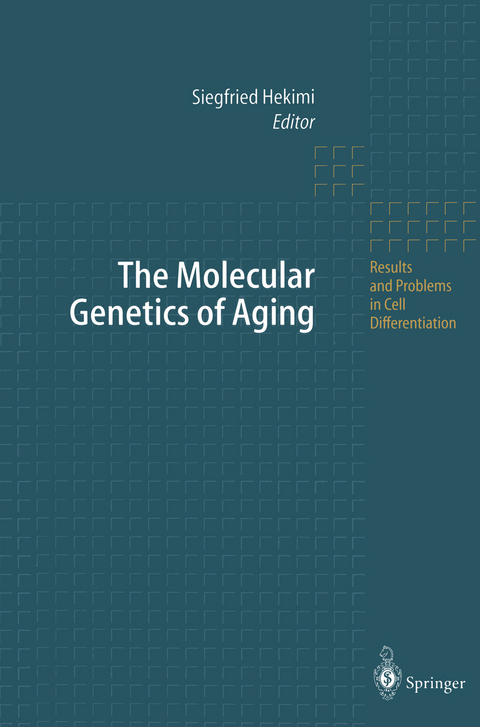
The Molecular Genetics of Aging
Springer Berlin (Verlag)
978-3-642-53686-1 (ISBN)
Centenarians and the Genetics of Longevity.- 1 Introduction.- 2 Are Centenarians a New Phenomenon?.- 3 Centenarians Are the Fastest Growing Age Group.- 4 Are Centenarians Different?.- 5 The Centenarian Phenotype: Compressing Morbidity Towards the End of Life.- 6 Evidence from Centenarians Supporting a Strong Genetic Influence upon Longevity.- 7 Siblings of Centenarians Live Longer.- 8 Parents of Centenarians also Achieve Unusually Old Age.- 9 Four Families with Clustering for Extreme Longevity.- 10 Middle-Aged Mothers Live Longer: An Evolutionary Link Between Reproductive Success and Longevity-Enabling Genes.- 11 In Our Near Future.- References.- Coordination of Metabolic Activity and Stress Resistance in Yeast Longevity.- 1 Introduction.- 2 Phenomenology of Yeast Aging.- 3 Genetics of Longevity.- 4 Physiological and Molecular Mechanisms of Aging.- 5 Primacy of Metabolic Control.- Current Issues Concerning the Role of Oxidative Stress in Aging: A Perspective.- 1 Introduction.- 2 The Concept of Life Span: A Cautionary Note.- 3 Metabolic Rate, Stress Resistance and Antioxidative Defenses.- 4 Current Evidential Status of the Oxidative Stress Hypothesis of Aging.- 5 Longevity Studies in Transgenic Drosophila.- 6 Hazards of Life-Span Analysis in Drosophila.- 7 Conclusions.- References.- Regulation of Gene Expression During Aging.- 1 Importance of Examining Gene Expression During Aging.- 2 Drosophila as a Model System for Studying Gene Expression During Aging.- 3 Enhancer Trap and Reporter Gene Techniques Can Be Used to Study Gene Expression During Aging.- 4 The Level of Expression of Many Genes Is Dynamically Changing During Adult Life in Drosophila melanogaster.- 5 Gene Expression Is Carefully Regulated During Adult Life in Drosophila melanogaster.- 6 Some Genes Are Regulated by Mechanisms That Are Linked to Life Span and May Serve as Biomarkers of Aging.- 7 The Expression of Some Genes Is Not Changed by Environmental or Genetic Manipulations That Alter Life Span.- 8 Use of Temporal Patterns of Gene Expression as Biomarkers of Aging.- 9 The drop-dead Mutation May Be Used to Accelerate Screens for Long-Lived Mutations.- 10 Studies on Gene Expression Suggest That Not All Things Fall Apart During Aging.- 11 Conclusions.- References.- Crossroads of Aging in the Nematode Caenorhabditis elegans.- 1 Introduction.- 2 Dormancy.- 3 The Rate of Living.- 4 Caloric Restriction.- 5 How Many Different Mechanisms?.- 6 A Unifying Hypothesis.- Contributions of Cell Death to Aging in C. elegans.- 1 Introduction.- 2 C. elegans as Model for Analysis of Molecular Mechanisms of Aging.- 3 Cell Death.- 4 Roles of Cell Death in C. elegans Aging, Future Directions..- References.- Stress Response and Aging in Caenorhabditis elegans.- 1 Introduction.- 2 C. elegans Life History - Life in a Stressful Environment.- 3 Longevity (Age) Mutations.- 4 Aging and Stress Response.- 5 Stress and Life-Span Determination.- References.- Oxidative Stress and Aging in Caenorhabditis elegans.- 1 Introduction.- 2 Genetics and Environment Causes of Aging.- 3 Isolation of Mutants.- 4 Fecundity.- 5 Life Span.- 6 Aging Markers.- 7 Superoxide Dismutase (SOD) Activity.- 8 Molecular Cloning of mev-1.- 9 Enzyme Activity of Cytochrome b560.- 10 Mutagenesis.- 11 Apoptosis in mev-1 and rad-8 Mutants.- 12 Mechanism of Cell Damage by the mev-1 Mitochondrial Abnormality.- 13 Other C. elegans Life-Span Mutants Show Abnormal Responses to Oxidative Stress.- 14 Closing Comments.- Mutation Accumulation In Vivo and the Importance of Genome Stability in Aging and Cancer.- 1 Introduction.- 2 In Vivo ModelSystems for Measuring Mutations.- 3 The lacZ-Plasmid Mouse Model for Mutation Detection.- 4 Monitoring Mutation Accumulation in Mice with Defects in Genome Stability Pathways.- 5 Summary and General Discussion.- References.- Delayed Aging in Ames Dwarf Mice. Relationships to Endocrine Function and Body Size.- 1 Introduction.- 2 Ames Dwarf Mice.- 3 Snell Dwarf Mice.- 4 Development and Longevity of Dwarf Mice.- 5 Longevity of Snell Dwarf Mice and the Issues of Husbandry.- 6 Possible Mechanisms of Delayed Aging in Dwarf Mice.- 7 General Conclusions and Future Directions.- Stem Cells and Genetics in the Study of Development, Aging, and Longevity.- 1 Introduction.- 2 Development as a Reversible Restriction of Developmental Potential.- 3 Stem Cell Populations Drive Developmental Systems.- 4 Stem Cell Populations as Critical Targets of Damage During Aging.- 5 Hematopoietic Stem Cells as a Model Population for Studies of Aging.- 6 Telomeres.- 7 A Link Between Stem Cell Replication and Organismal Life Span in the Mouse.- 8 Conclusions and Final Thoughts.- References.
| Erscheint lt. Verlag | 28.7.2012 |
|---|---|
| Reihe/Serie | Results and Problems in Cell Differentiation |
| Zusatzinfo | XVI, 240 p. 106 illus., 28 illus. in color. |
| Verlagsort | Berlin |
| Sprache | englisch |
| Maße | 155 x 235 mm |
| Gewicht | 403 g |
| Themenwelt | Naturwissenschaften ► Biologie ► Biochemie |
| Naturwissenschaften ► Biologie ► Mikrobiologie / Immunologie | |
| Naturwissenschaften ► Biologie ► Zellbiologie | |
| Schlagworte | Age • aging • Altern • Altern / Älterwerden / Altwerden • Cancer • enzymes • gene expression • genes • Genetics • Influence • Lebenserwartung • Lifespan • Longevity • molecular genetics • Molecular mechanisms • Molekulargenetik • Morbidity • Regulation • Telomere • termination • Vivo |
| ISBN-10 | 3-642-53686-7 / 3642536867 |
| ISBN-13 | 978-3-642-53686-1 / 9783642536861 |
| Zustand | Neuware |
| Haben Sie eine Frage zum Produkt? |
aus dem Bereich


